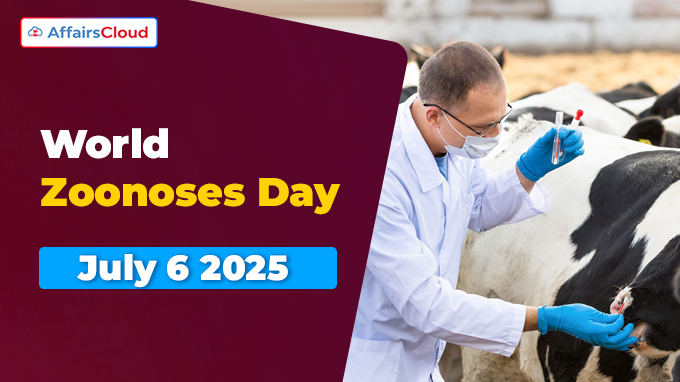 World Zoonoses Day is annually observed across the world on July 06 to raise awareness about Zoonosis or Zoonotic disease, an infectious disease that is naturally transmissible from vertebrate animals to humans.
World Zoonoses Day is annually observed across the world on July 06 to raise awareness about Zoonosis or Zoonotic disease, an infectious disease that is naturally transmissible from vertebrate animals to humans.
- The day aims to prevent the spread of zoonotic diseases, control zoonoses by managing threats for future infections, and promote preventive healthcare practices.
Background:
i.The day commemorates the anniversary of the day that Louis Pasteur, a French chemist, and microbiologist, administered the 1st vaccine for humans against rabies, a vaccine preventable viral zoonotic neuro-invasive disease which is usually fatal.
ii.In July 1885, Louis Pasteur administered the rabies vaccine to save the 9-year-old Joseph Meister who was bitten by a rabid dog.
iii.The event is supported by major health organizations such as the World Health Organization (WHO), Food and Agriculture Organization (FAO), World Organisation for Animal Health (WOAH, formerly OIE), and various national governments.
About Zoonosis:
i.It is an infectious disease that transfers from non-human animals to humans and the zoonotic pathogens may be bacterial, viral, parasitic, or involve unconventional agents.
- Examples of zoonotic diseases include Zika virus, Ebola virus, avian flu, SARS (Severe Acute Respiratory Syndrome), MERS (Middle East Respiratory Syndrome), West Nile virus, Lyme disease, and yellow fever.
ii.It can be transmitted between animals and humans, either through direct contact between humans and infected animals, contaminated food, water, or the environment.
iii.Zoonoses comprise a large percentage of new and existing diseases in humans and there are more than 200 known types of zoonoses.
iv.Globally, over 2/3rd of emerging infectious diseases have their origins in animals. Some of the zoonotic diseases are: Zika virus, Ebola virus, avian flu, West Nile virus, among others.
Prevention and Control:
i.Safe and appropriate guidelines for animal care in the agricultural sector will help to prevent food-borne zoonotic disease outbreaks.
ii.Ensure clean drinking water and effective waste removal.
iii.Protect surface water in the natural environment.
iv.Promote handwashing after contact with animals through education campaigns.
WHO’s Response for Zoonotic Disease:
i.World Health Organisation (WHO)’s ‘One Health’ is an integrated, unifying approach that mobilizes multiple sectors, disciplines and communities at varying levels of society to balance and optimize the health of people, animals and the environment.
ii.As part of the One Health approach, the WHO collaborates with Rome (Italy) based Food and Agriculture Organisation (FAO); and Paris (France) based World Organisation for Animal Health (WOAH) on the Global Early Warning System for Major Animal Diseases (GLEWS).
Initiatives to Combat Zoonotic Diseases in India:
India has implemented multiple programs aimed at protecting people from zoonoses, including:
i.National Animal Disease Control Programme (NADCP):Launched in 2019, this program focuses on preventing and controlling animal diseases like Brucellosis and Foot and Mouth Disease.
ii.Mobile Veterinary Units (MVUs): Introduced in 2021-22, these units deliver on-site veterinary services to enable early detection and treatment of animal diseases.
iii.National One Health Mission: Launched in 2022, this initiative integrates human and animal health efforts to ensure a coordinated response.
iv.Animal Birth Control Rules 2023: Emphasizes vaccination and sterilization of stray animals to curb rabies transmission.
v.Vaccination Campaigns: Promote regular immunization of pets and livestock among animal owners.
About World Health Organisation (WHO):
Director General (DG)- Dr. Tedros Adhanom Ghebreyesus
Headquarters- Geneva, Switzerland
Established – 1948




